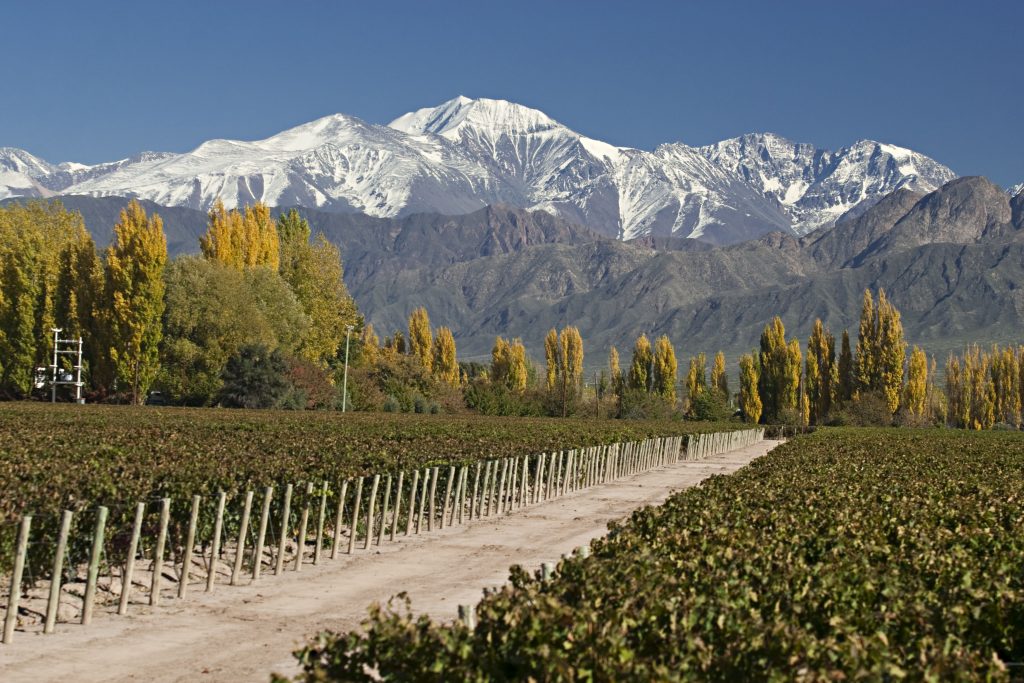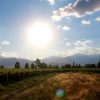The wine routes of Argentina are among the most chosen by wine lovers: for the quality of the services they offer, because each region combines wine tourism with natural attractions and because they can be enjoyed all year round. Thanks to the vast array of natural attractions and climatic conditions, a wine tour in Argentina is an unforgettable experience. There are things to see and do in each region, not only touring wineries and vineyards. If you´re in the process organising a trip to Argentina, below you´ll find the best time to visit each of our regions.
Spring-summer, Patagonia
The south boasts 3,600 hectares of vineyards distributed between La Pampa, Río Negro, Neuquén and Chubut. An important number for four provinces more famous for their ski centres than for their wines. There’s Bariloche, La Hoya and Villa la Angostura, which are highly chosen destinations by lovers of skiing and snowboarding.
But Patagonia is also recognised for its National Parks, such as Los Alerces and Nahuel Huapi, the forests of Coihues and Arrayanes, lakes like mirrors such as Gutiérrez, Traful and Puelo and many mountain villages and towns that annually attract thousands of tourists looking for tranquility or some of the many activities that allow you to enjoy the stunning natural surroundings.
Others come for the regional gastronomy: lamb, deer and wild boar, smoked trout and Argentinean seafood such as crabs, prawns and black trout, delicacies that always taste good in the company of a glass of wine, and if it is Patagonian, much better. For those who plan to visit Patagonia to discover its flavours and enter its vineyards and wineries, we recommend doing it between September and March, months in which you will find the most southern vineyards in the country in full activity, and an ideal climate without the risk of rain or snow.
It is even a good time to take excursions to other Patagonian attractions, such as hiking through the Lanín volcano or up a few mountain peaks, fly fishing on the Limay River or the Correntoso and even visiting the deserts in search of the footprints of dinosaurs that once inhabited this inhospitable region of the planet and then carry on to Villa El Chocón, Neuquén.
Autumn and winter, Northwest Argentina
The Calchaquí Valley, to the northwest of Argentina, seduces more visitors every year. It crosses the viticultural provinces of Catamarca, Tucumán and Salta and forms a region that, besides good wines, ensures more than three hundred sunny days a year with a hot, dry climate, in Summer. But the ideal seasons are Autumn and Spring, when the daytime temperatures average 20 degrees and there is no risk of rainfall.
The high altitude vineyards, between 1,700 and 3,000 meters, is one of the main attractions. Although the nights are cool, even in summer, the power of the sun in this mountain terroir should be taken into account and protection from UV rays is always a sensible idea at least with a cap or hat. This is particularly important for outdoor activities, such as horseback riding in the hills and ravines or adventure tourism excursions, either in the Cordillera valleys or on the high steppe that the Dakar Rally goes through every year.
At this time of the year, remote wineries such as Colomé and Tacuil can be accessed without problems. From Cafayate to Cachi and then the Cuesta del Obispo to the capital, Salta, the only possible inconvenience is the off road terrain, which adds to its wild charm. In Tucumán, near the vineyards, the Sacred City of the Quilmes awaits with its archaeological treasures, while in Jujuy the Quebrada de Humahuaca is also worth a visit.
The wine regions of San Juan and La Rioja can be found in Cuyo. Both provinces, like Salta, enjoy a dry, hot climate and offer incredible natural attractions, such as the Ischigualasto Provincial Park in San Juan and the Talampaya Canyon in La Rioja.
Mendoza, all year round
The principal viticultural province of the country ensures tourist attractions all year. This advantage has made it one of the ten wine regions of the world and has given it the recognition of Great Wine Capital. Its valleys and mountains not only offer vineyards and wineries open to tourism, but they also provide an endless supply of activities. From June to August and even September, the ski centres of Penitentes, Potrerillos and Las Leñas bring together skiers who rarely miss the opportunity to stop in the wineries on their way to the ski slopes. While in Spring and Summer, fans of trekking, mountain biking and extreme sports take the opportunity to explore the Cordón del Plata, the Huayquerías, the canyons in San Carlos, or rivers such as the Atuel and lagoons high up in the mountains like Laguna del Diamante.
Aconcagua National Park is also well worth a visit and is home to the highest peak in America. A magnet for the most experienced climbers in the world, with some routes suitable for amateurs as well. However, those whose sole objective is to visit the most extensive wine region of South America and discover endless vineyards and stunning wineries should be aware that in harvest time, from January to April, the days can be very hot, so it is advisable to start the tours early in the morning or after lunch. There are many wineries which offer delicious food such as Familia Zuccardi in Maipú, Killka, Bodega Salentein in Valle de Uco or Bodega Séptima in Luján de Cuyo.
Autumn is also a wonderful season to come to Mendoza as the temperatures are more friendly and with a light jacket you´ll be comfortable on the tours. In winter, it gets much colder and there may even be days with freezing temperatures, but snow is rare. Spring is perhaps the ideal time for its long, sunny days with very pleasant temperatures.
Whatever the season, Argentina offers the world traveller the chance to enjoy the best of the best while discovering the secrets of its wines. It is a place that demands more than one visit and can be reached at any time of the year. So what are you waiting for!



